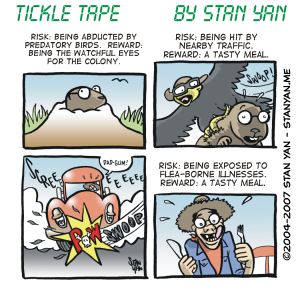Market action is driven by fear and greed. Masses of market participants follow each other to their doom. It’s a fact. If it weren’t true, winning traders couldn’t take advantage of herd instincts and take home huge profits. As a trader, you must make a key decision: Do you follow the crowd or do you go your own way?
Following the crowd isn’t always bad. In the strong bull market of the late 1990s, the market went virtually straight up, as if resistance were a hypothetical construct of a bygone era. But these days, we aren’t so lucky. One month the market is bullish; the next month it is bearish. If you followed the crowd, you would end up selling when there were no buyers and mounting big losses. It’s vital to anticipate what the crowd will do, and sell relatively early, on strength, when there are plenty of buyers. It’s counterintuitive but necessary.
Going against the crowd isn’t easy. We have a human, adaptive tendency to follow the crowd. Following the crowd usually keeps us safe, like fish that swim in schools for protection. The old adage, there’s safety in numbers, is true most of the time. But traders would do better to act like rugged individualists.
Rugged individualists aren’t always popular, though, and may get into trouble. Consider the plight of Hayden Roark, the protagonist in Ayn Rand’s novel, “The Fountainhead.” Howard Roark is a creative, innovative architect who shuns the classical style that is popular among his colleagues so he could design modern structures that fully reflect his creativity. Ignored by the mainstream, he can find no clients and must support his craft by working as a laborer in a quarry or designing modest projects, such as family homes, gas stations, and small office buildings. But he doesn’t mind. He isn’t driven by money, fame, or recognition.
He is motivated solely by a powerful need to express his artistic vision. He works his craft to satisfy himself and no one else. For him, designing buildings has nothing to do with raising his status in the eyes of his peers. He does it solely for artistic expression. It’s either his own way, on his own terms, or nothing. He would rather turn down a job than let a client change his design. Indeed, Hayden Roark takes individualism a bit too far. When a change is made to his design of a public works housing project by the city government, he bombs it and suffers the consequences. But, generally, following your own instincts gets you far.
Rugged individualists are resilient and persistent. At their core, their self-esteem is true and unwavering. As Dr. Nathaniel Branden observes, “When we appreciate the true nature of self-esteem, we see that it is not competitive or comparative. It is not about making myself higher by making you lower. It has nothing to do with you. It is the joy of my own being.”
Winning traders are extreme individualists. They see trading as an art form. They aren’t concerned with the status and prestige that riches may bring. They love what they do and enjoy the benefits of working for themselves and being accountable to no one. They go their own way and know deep down that they are meant to be traders. It’s not just a job; it’s a calling. The more you can think like an individualist, the more you’ll be able to anticipate the behaviors of the masses and capitalize on their tendency to follow the crowd.


